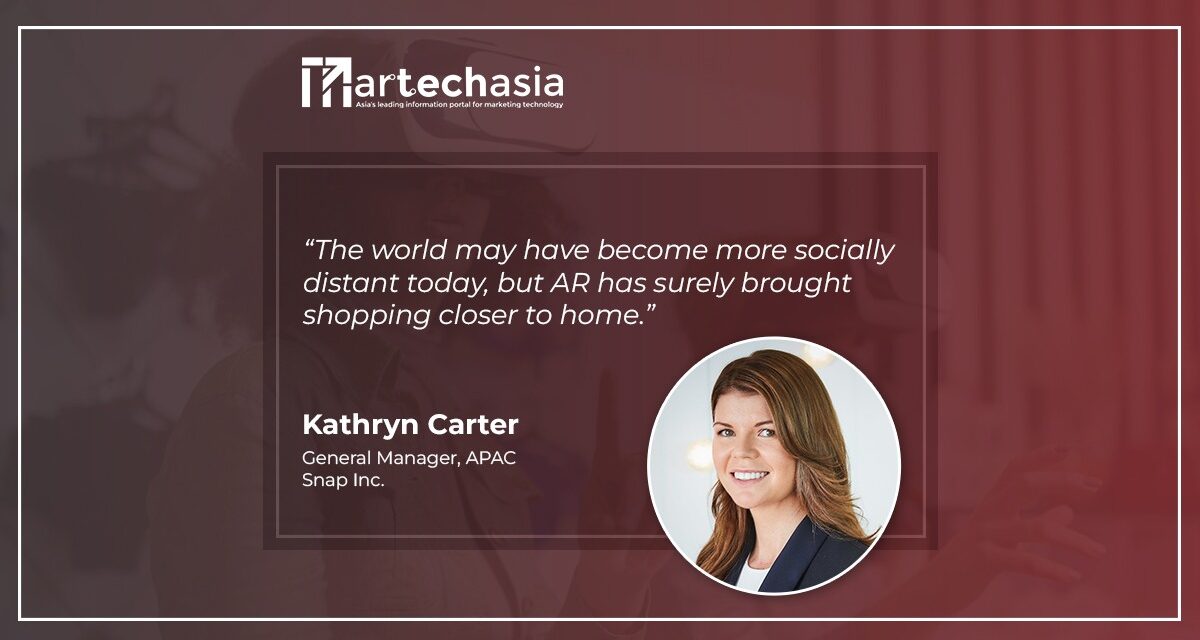Kathryn Carter shares her insights about how AR will shape the future of shopping and how brands can leverage the power of AR to drive results and boost consumer confidence.
What sounds like paradoxes – trying on new outfits without changing clothes, trying different colors and styles of shoes without wearing any – is now a reality, thanks to Augmented Reality (AR) shopping. Online shopping for everything has now become a mainstay after more than two years of the pandemic. Even as places and activities reopen, online shopping habits will likely remain.
While online shopping has come with its ease, imagine making it even better and more convenient so consumers can make purchases more quickly and easily, and return fewer orders.
Revolutionizing shopping one smart device at a time

AR is pushing the boundaries of imagination in online shopping. Virtual stores boomed during the pandemic but were unable to provide the same in-store experience. Even now, as pandemic-related restrictions vary and continue to evolve, stores are grappling with changing rules and new consumer preferences.
With AR shopping, e-commerce sites can offer consumers the ability to virtually try on their choices to see how they look before making a purchase – so much so that 69% of consumers now think that AR is the future of shopping. This comes as no surprise after 32% of people increased their use of shoppable AR during the pandemic.[1]
With physical shopping being taken over by virtual shopping, brands now need to step up and make an effort to meet consumers where they are, instead of expecting consumers to be present at their physical outlets. What this means is that consumers are increasingly expecting to experience brands, their products, and make purchases – from anywhere, at any time, and via their preferred medium, without being restricted by physical stores or the collections each outlet has.
With 28% (and an increasing number of) shoppers ready to substitute in-person experiences with AR[2], brands (and marketers) shouldn’t think of AR as an add-on but instead as an always-on tool to build and amplify their messaging. They could look to combine AR with other ads to not only help boost positive association but also purchase intent with the brand.
Boosting consumer confidence to boost purchases
AR is rapidly personalizing the product to the individual shopper by overlaying it on their faces, bodies or home settings. Some apparel brands are even tapping into the latest AR technology, such as body gestures and voice recognition, allowing customers to use their hands or voice commands to change outfits.
This personalization is not only fun for the shopper but also gives them more confidence in their decisions, driving incredible results for brands. Snap research shows that AR delivers almost 2x the levels of visual attention compared to non-AR equivalents, leading to improved memories and more impactful connections with consumers. As a result, 80% of shoppers feel more confident in their purchases when they use AR for shopping. Consequently, AR-guided purchases lead to a 25% decrease in returns and interacting with products with AR has a 94% higher purchase conversion rate.[3]
Ulta Beauty, for instance, has reaped the benefits first-hand, generating 30 million product trials and US$6 million in product purchases through Snapchat’s Shopping Lenses.
The full shopping experience in one app
Easy-to-use and accessible AR experiences drive customers to share with friends and families what they’ve bought via shopping lenses, get their feedback quickly, and leave tips and reviews for other potential buyers, creating a growing cycle of new and repeat purchases – all within one platform.
For brands, AR lenses within an app render endless possibilities and provide room to showcase their products creatively and as close to reality as possible with measurable results. A study showed that 7 out of the top 10 drivers of Purchase Intent are AR experiences[4]. This shows the significant influence that AR has on in-app shopping experiences.
Case in point is Zenni Opticals – an online-only retailer of prescription glasses and sunglasses – that posted a 42% higher return on ad spend using shopping lenses with true-size technology. Their AR Lenses have been tried on over 60 million times by Snapchatters alone.
In-house shopping is the new in-store experience
Unlike anything consumers have seen before, they can now shop for new outfits, make-up and shoes from the comfort of their own home with the same in-store experience. Advanced detection features like body measurements, seeing a product applied on you against your skin tone and physique, and how it looks from different angles help shoppers make quicker and faster shopping decisions.
According to a global shopping study, one in four shoppers said they would actually prefer to use AR to try on clothes virtually rather than visit a store to do so in real life. And why not maximize the comfort of your own home and experiment with the latest styles? Go from “Hey, that looks good” to “Hey, that looks good on me”. Even post-shopping, consumers are looking for AR-driven usage instructions and pairing recommendations, creating new and multiple opportunities for brands and marketers to engage them.
Undoubtedly, the integration of AR-enabled shopping experiences is creating a win-win opportunity for brands and consumers alike. The best way for brands to cut through the clutter online and create strong recall then will be by continuously understanding the information needs of their target consumers and being nimble enough to meet those needs with AR technology as they evolve. To strengthen brand recall and trust, brands must leverage interactive and exciting technologies like AR to create powerful visual, engaging, and memorable experiences.
The world may have become more socially distant today, but AR has surely brought shopping closer to home.
[1] https://forbusiness.snapchat.com/blog/exploring-the-utility-of-ar-in-marketers-ecommerce-plan
[2] https://forbusiness.snapchat.com/blog/exploring-the-utility-of-ar-in-marketers-ecommerce-plan
[3] https://forbusiness.snapchat.com/blog/exploring-the-utility-of-ar-in-marketers-ecommerce-plan
[4] Snapchat and Publicis Media Study, in partnership with Alter Agents, Shoppable AR: The Next Frontier in E-commerce, April 2022


















